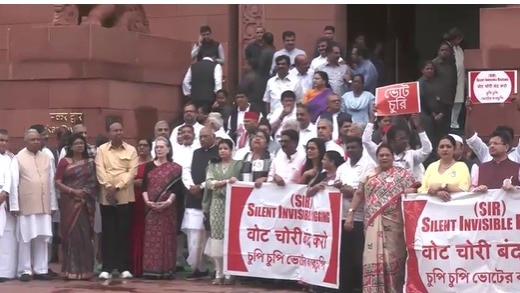ARTICLE AD BOX
Gurugram's rise as a corporate powerhouse has come at the expense of its rivers, wetlands, and the Aravallis that once sustained it. The Sahibi River, the Aravallis, and their forests are now either gone or in a dire state. The city's recurring floods, choking dust, and vanishing green cover are the direct fallout of decades of unchecked, ill-planned "development", which, in effect, have been the reasons for their disappearance.
Decades before Delhiites jammed NH-48 and Mehrauli-Gurgaon Road to flock to Gurugram for their offices or nightlife, parties, and booze, the cluster of 'grams' southwest of the capital, set on the Aravalli slopes with forests scattered around, was home to ashrams, farmlands, ponds, and seasonal streams flowing down from the world's oldest mountain range. In the 1970s and 1980s, famed yoga guru Dhirendra Brahmachari and even Prime Minister Chandra Shekhar chose Gurgaon as a quiet corner for peace. But all that was before the century turned. It was before the new millennium rolled in, and the rustic retreats gave way to a booming, ever-swelling urban sprawl, which is now full of civic mess that makes the moniker "Millennium City" feel like a question mark. It is hard to imagine that a river and many seasonal streams once flowed through Gurgaon.
Now, Gurugram, contributing nearly 65% of Haryana's income tax collections and hosting tech giants such as Google, Microsoft, and a number of Fortune 500 companies, often finds its streets waist-deep in water, thoroughfares turned into canals, roads drowned, manholes left gaping, live wires hanging dangerously, cars adrift, and commuters trapped in gridlocks that can stretch from four to eight hours.
If the transformation of Gurgawan — from its ashram days of Aravallis, rivers, and streams — into a glass, steel, and concrete sprawl was a sharp turn, the scene today is of an even sharper twist. Residents, having spent crores on apartments and lakhs in taxes, step out of gated high-rises only to wade through knee-deep water on the city's pried Golf Course Road, whether the rain is 50 mm or 150 mm.
So where did Gurugram's rivers, Aravalli hills, and jungles vanish? What became of the Sahibi River?
The forests were felled and flattened, rivers and wetlands encroached upon, their spaces claimed for the post-liberalisation boom. Businesses thrived, Gurugram prospered. But this "development" came at a hefty price. The civic chaos the city faces today is a direct outcome of the gradual dismantling of its natural environment, once defined by the Aravallis, their green cover, a number of lakes and bundhs and the Sahibi River.
WHO KILLED GURUGRAM'S WATER LIFELINE, SAHIBI RIVER?
The Sahibi River, once a seasonal lifeline flowing from the Aravallis in northern Rajasthan's Sikar, passed through Haryana into Delhi. It still flows, but now it's been reduced to what is called the Najafgarh drain in Delhi.
Once, the Sahibi River was an integral part of Gurgaon's hydrology. Along its course once lay wetlands, ponds, and riparian ecosystems, such as the Basai Wetland, Masani Barrage, and a chain of village ponds that sustained farming in the region. Fragments of which still survive, though greatly depleted.
Today, the two stretches of the Sahibi within Haryana, running along Gurugram's northwestern boundary, are described as "ecologically dead".
It is polluted, encroached upon in places, and is cut off from its natural water sources. The Masani Barrage (in Rewari district) has been largely dry since the late 1980s, because of declining rainfall, upstream diversions, and unchecked construction along the Sahibi River's course.
However, the destruction extends beyond the main river.
In Basai village, Gurugram district, five of its six ponds were paved over in just 12 years. They disappeared by 2019, noted a Hindustan Times report from that year.
The ponds had been buried under residential sectors, a school, or poisoned by industrial effluent.
Without these water bodies, Gurugram's natural drainage and groundwater recharge systems have been under immense strain. Concretisation of surfaces and stormwater drains in Gurugram has worsened the situation in the rainy season, when excess water that should have been collected in these waterbodies is now left trapped on roads and open spaces in the concrete jungle.
Isn't anyone responsible for the mess that Gurugram has become?
In response to a starred question from Rohtak MP Deepender Hooda on the civic woes of Gurugram, Minister of Housing and Urban Affairs Manohar Lal Khattar said that while urban planning is the function of urban local bodies (ULBs) or urban development authorities, the Centre supplements the efforts of the states through financial and technical support.
Last week, Khattar, in an answer in the Parliament, said that the unique topography, featuring the Aravalli hills to the east and the Najafgarh drain to the northwest, was the reason for instances of waterlogging in Gurugram.
"The elevation difference of about 78 metres between the Najafgarh drain and the Aravalli hills has created a natural gradient for water flow, which was historically controlled through a series of bunds constructed in the late 19th century, such as Chakarpur, Jharsa, Wazirabad, and Ghata bunds. However, rapid urbanisation has rendered many of the bunds obsolete and reduced pond networks, impacting the traditional drainage system," Khattar said in response to Hooda's question.
The excess water, which once flowed northwest along Gurugram's natural gradient to reach the Sahibi, no longer makes it there. As a result, the river (which is now essentially a drain) isn't recharged, and the water ends up stagnating on the concrete streets, with little earth left to enable seepage.
TERI’s 2018 Gurgaon Flooding Report and NIUA hydrological mapping conclude that Gurgugram's urban drainage plan ignored natural flow patterns. That's why even light rain turns the planned sectors into waterlogged pockets.
If the Sahibi River has died a slow death, the Aravalli hills to the east and north, and the green cover over it, have been dealt a faster blow.
ARAVALLIS, ONCE A NATURAL SHIELD OF GURUGRAM, IS NOW UNDER SIEGE
Like the waterbodies, the ancient range of the Aravallis, the oldest in the world, once shielded Gurugram from desertification, filtered its air, and housed leopards, hyenas, and native tropical dry deciduous thorny forests.
Despite a Supreme Court ban on mining in parts of the Aravallis in Gurugram, Nuh, and Faridabad since 2009, illegal extraction of stone and sand remains rampant. Several environmentalists and citizens' pressure groups have urged the government to designate the Aravallis a no-go zone with strict enforcement and restoration of degraded sites, but state compliance has been patchy.
In Gurugram's Sonha, illegal stone quarries have flattened hillocks, causing permanent damage to the Aravalli range, as documented in a 2019 Down To Earth investigation report.
In 2020, an entire Aravalli hillock was reportedly flattened to build an approach road for farmhouses being constructed in Bandhwari, around 1.5km off the Gurugram-Faridabad highway. It was the second reported disappearance of a hill in that section of the range since 2018, when the Supreme Court learnt that one-fourth of the Aravalli hills in neighbouring Rajasthan had vanished.
In June, a 33-foot-wide illegal concrete road was laid in Basai Meo (in adjoining Mewat district), to aid mining inside a protected zone, The Times of India reported.
Of the 582 recorded cases of illegal mining in Aravallis, there has been just one conviction, reported the Business Standard in 2023. Multiple NGT and Supreme Court orders have demanded online complaint systems, CCTV monitoring, and district-level action plans to safeguard what remains of the Aravallis, but enforcement remains weak.
The ecological cost has been severe. Deforestation has invited dust storms from the Thar, accelerated desertification, depleted groundwater, and raised the NCR's already dangerous air pollution levels.
GURUGRAM REVENUE WINDFALL, DEVELOPMENT SHORTFALL
Once a semi-arid agricultural area, Gurugram has morphed into one of India's wealthiest urban centres. It hosts the Indian offices of several of the Fortune 500 companies, tech giant Microsoft, and serves as headquarters for giants like Coca-Cola, BMW, Hyundai, and Cargill. Gurugram also boasts India's third-highest per-capita income and adds the highest tax money to the Haryana government's kitty.
Despite the wealth, residents face infrastructure that businessman-columnist Suhel Seth condemned as "slum-like".
"It's bizarre. The richest people live in slum-like environments," Seth said.
In July, former Jet Airways CEO Sanjiv Kapoor called out Gurugram's civic authorities over poor waste management, sharing photos that revealed the grim reality of Sector 44's streets.
Gurugram has turned out to be a city of governance failure, masked by skyscraper gloss.
Civil Servant and IRTS officer, J Sanjay Kumar, said that replacing concrete with green cover, protecting wetlands, and allowing water to seep into the ground is the key to preventing urban flooding, something Noida has done better than Gurgaon.
"Remove the concrete jungle, let water percolate. Plant trees to absorb excess water. Protect wetlands which store water. Only solution to prevent urban flooding. This is the reason Noida has better conditions than Gurgaon. Noida has at least better green cover than Gurgaon," Kumar posted on X last week.
Until positive and corrective measures are taken, things are to remain as they have been for a decade now.
Meanwhile, the Municipal Corporation of Gurugram (MCG) rolled out an AI-driven property tax recovery mechanism, pulling in Rs 200 crore so far, including Rs 95 crore in July alone, according to a report in The Times of India. But as the concerns naturally follow, many argue this windfall must turn into real development, not yet another case of wasted potential.
Gurgawan's journey from a quiet suburb under the shade of the Aravalli to a global corporate hub came at a steep price. The cost has been the erasure of its own rivers, wetlands, and hills. The urban floods, heat islands, and dust-laden air aren't random crises. They're the echoes of large-scale environmental dismantling. There's still a chance to fix what's been damaged. But bold steps must be taken now, before these changes become irreversible.
- Ends
Published By:
Sushim Mukul
Published On:
Aug 12, 2025



.png)
.png)
.png)
















 2 hours ago
3
2 hours ago
3









 English (US) ·
English (US) ·